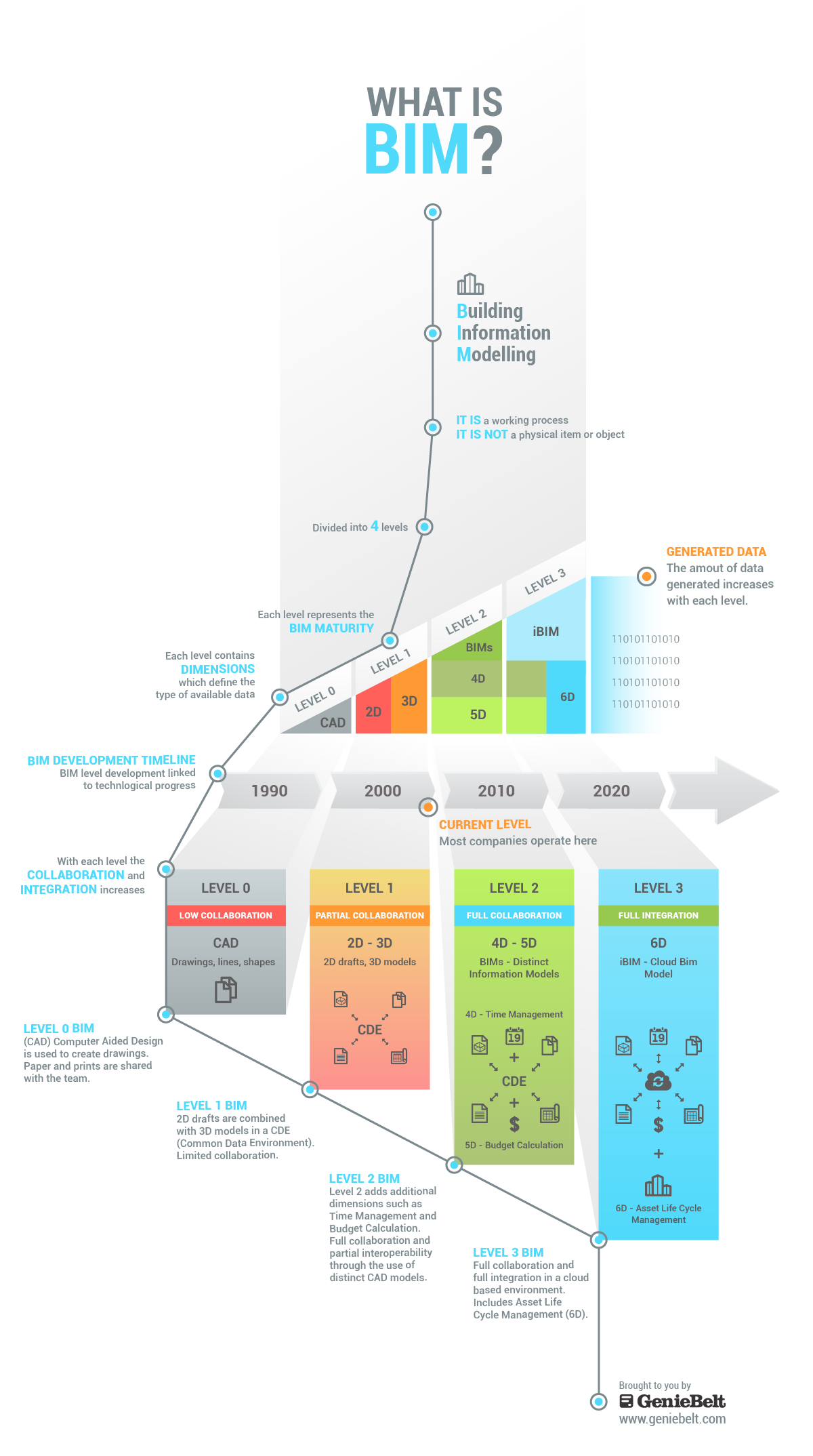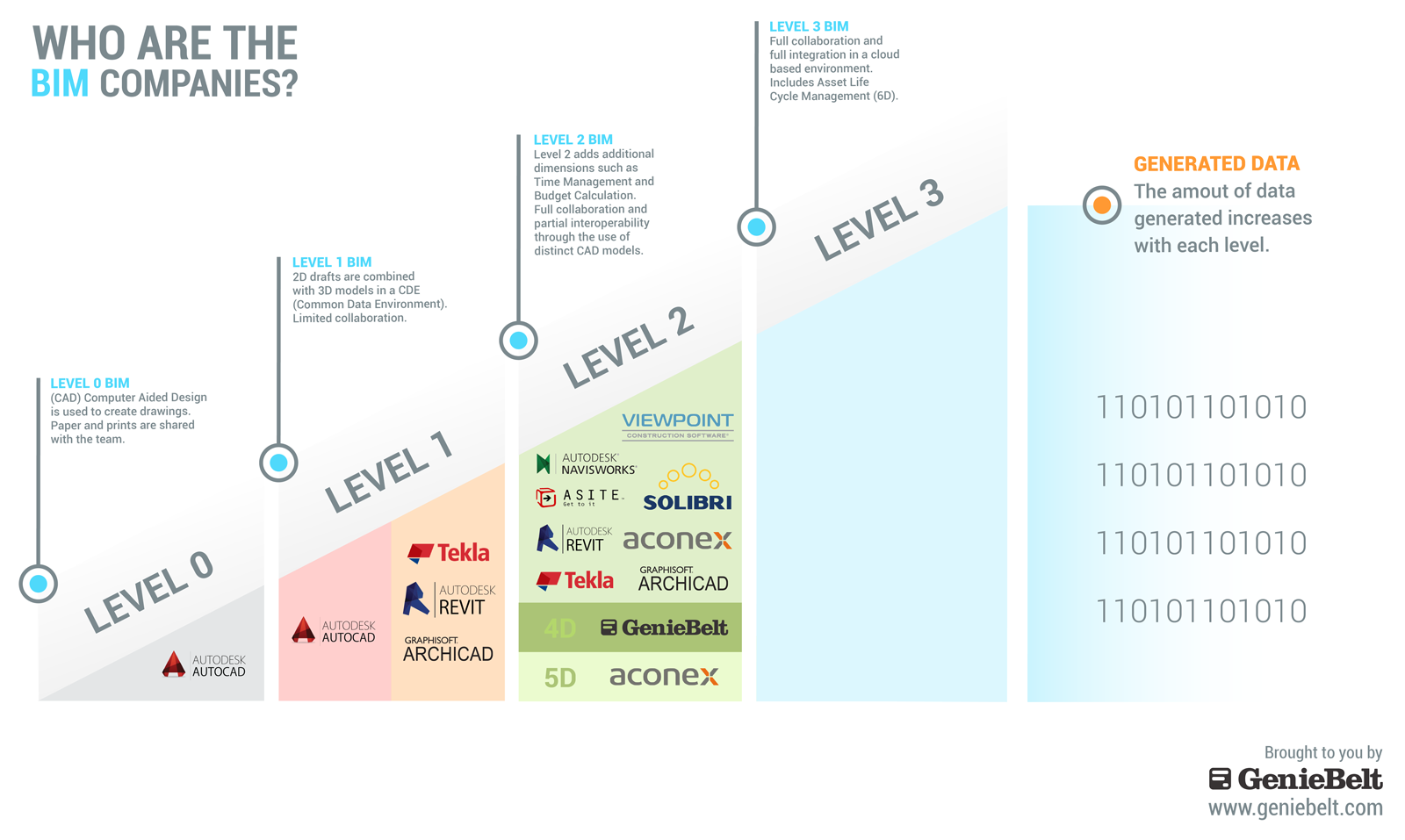The future of construction - BIM
[edit] Introduction
Building Information Modelling (BIM) can be a valuable tool in the hands of anyone who works in construction. There’s no doubt that the concept of collaborative working is becoming more and more popular, that’s why it’s critical for all construction agents to be aware of the different BIM maturity levels.
[edit] What BIM actually is
To put it simply, BIM refers to a collaborative method of working which is based on the generation and exchange of data and information between the various project parties. Based on this information the full cycle of a building, from conception to completion, can be managed. In that sense, it’s an indispensable part of the decision-making process. BIM started gaining attention in the 90’s and it has evolved remarkably during the last decades.
There are different levels of shared collaboration in a construction project. Those are known as BIM maturity levels. As we proceed through the levels, the collaboration between the various sides is increasing. At the time being, there are four distinct BIM maturity levels.
[edit] BIM Level 0 (low collaboration)
It’s the simplest step of the information generating process. It doesn’t practically involve any level of cooperation. In this phase, the production and sharing of the information are taking place with the help of paper and non-interoperable electronic documents.
CAD drawings are used during Level 0, but there is no sharing of the generated information models. The industry has already surpassed this step and is heading to a more collaborative way of producing and distributing the necessary information.
[edit] BIM Level 1 (partial collaboration)
A large number of companies are at the moment conducting their work on this level. A Common Data Environment (CDE) is used in this case. A Common Data Environment or CDE is an online shared repository where all the necessary project data are collected and managed. Software like Aconex, Viewpoint or UsBIM.platform can be used as the CDE.
The contractor is normally the one who manages a CDE. In a few words, BIM Level 1 is focusing on the transition from CAD to 2D and 3D pieces of information. Despite the presence of a Common Data Environment, the generated models are not distributed amongst the different agents.
[edit] BIM Level 2 (full collaboration)
The main focus of interest on this level is the way in which the information is shared across the various project members. Two new dimensions, related to project management, are introduced at this level. It’s the 4D (GenieBelt) which is related to time management and the 5D (Aconex) which is linked to the calculation of the budget.
The PAS 1192 specification is also of imperative importance, as it designates the necessary conditions for a construction project to reach in BIM Level 2.
Collaborative working is at the core of BIM Level 2. Nevertheless, it doesn’t require every side involved in the project to operate on the same 3D CAD models. To the contrary, everyone is free to use a distinct CAD model. What is really important is the existence of a common file type (an IFC file for instance) that contains all the design information.
In other words, we are talking about a model of full collaboration amongst the numerous project sides. In that way, the parties connected to the project can have an overview of all the available information and modify it accordingly. Thanks to this, they are able to put together a unified BIM model. Last but truly important detail is that the CAD software, that every party uses, should have the ability to export in common file types (eg. IFC files, COBie files etc.).
Countries like the UK are already pushing hard towards that direction. The UK government mandate for adopting the BIM Level 2 model by 2016 in every public project makes clear that there’s a strong focus on optimising the construction process.
[edit] BIM Level 3 (full integration)
BIM Level 3 is the ultimate goal for the construction industry. Its main point is the attainment of full integration (iBIM) of the information in a cloud-based environment. This will be achieved by the use of a common shared model. The model will be accessible to anyone that has something to do with the project.
On top of that, the various agents that work in the project will be able to edit it and/or add their own piece of information. A new dimension (6D) which is focusing on the management of the building’s life cycle is expected to be added at this point. Dimensions related to time (4D) and cost (5D) are also available.
At the moment, there are still certain doubts around copyright and responsibility issues. But those are expected to be solved, as the whole process is progressing.
[edit] BIM dimensions
A common misconception around BIM has to do with its dimensions. The dimensions are different than the BIM maturity levels. BIM dimensions are inextricably connected to the type of data that can become available through the process. They can be found both in BIM Level 2 and Level 3.
There are four types of BIM dimensions:
- 3D: Refers to 3D generated drawings.
- 4D: Linked to time management.
- 5D: Concerns data that have to do with the cost of the project.
- 6D: A dimension dedicated to the life cycle management of a building.
[edit] The importance of model checking
Model checking is a fundamental element in computer science and by extension in BIM. Model checking could be described as the detailed process of examining a particular system model on whether or not is meeting certain criteria. It’s understandable that model checking has tremendous importance for BIM.
There are various BIM viewer tools that could help a lot during this effort. Solibri and Navisworks are two reliable software that can offer a lot towards that direction. In a sentence, they could be used for design coordinating and compliance checking purposes. Similarly, a tool like Revit can be part of this procedure.
[edit] What the future brings
The transition to BIM Level 2 and hopefully soon enough to Level 3 will have some important benefits for the construction industry. In short, we could sum up some of them below:
[edit] Boost In productivity
The ability to share information faster and easier can offer a significant productivity boost. Collaborative working can decrease the required time for incorporating and editing new information. Increased productivity means also lower cost and by extension higher efficiency in terms of project planning.
[edit] Big Data
Building Information Modelling will offer remarkable help in handling vast amounts of data. The more effective managing of big data will change the way many of the professionals within construction (eg. contractors, engineers etc.) are working. It’s expected that a higher demand for data will emerge, as well.
[edit] New possibilities for smaller markets
BIM can play a great role in the optimisation of the construction process. This element may very soon lead to the opening and development of new markets which until now did not have the right tools in order to expand. Thanks to a fully or partially integrated collaborative model, they will be able to tackle a big number of difficulties that they face on a daily basis at the moment.
[edit] Buildings Of higher quality
The larger amount of data in conjunction with the ability to manage them with higher precision will eventually lead to a remarkable improvement of the quality of our buildings. To put it simply, more complex buildings that have much more to offer to their residents will be designed and built.
Parameters such as the environment and the modernisation of the designed structures will be easier to be taken into consideration during the building procedure.
[edit] Improved clash detection
Thanks to BIM, the clash detection process is drastically ameliorated. The term clash is referring to potential mistakes that emerge during the design and construction of a building. BIM can help a lot in clash detection and as a result in increasing the project’s efficiency. IFC files offer great assistance during this process.
[edit] Who are the BIM companies?
There is already a decent number of companies which play a significant role in this transition from partial collaboration to full integration.
GenieBelt (4D) is a vital part both of BIM Level 2, as it is inextricably connected with the project task management. Same goes for Aconex (5D) whose main point of focus is on providing a CDE and the cost management of a project. Solibri, Revit and Tekla are mainly part of BIM Level 1 and Level 2. There is also Asite and Viewpoint which can contribute in BIM Level 2 as CDE. Finally, in the BIM Level 0 and Level 1, we come across Autodesk Autocad.
Have a closer look to the infographic below and get a better overview of the companies that are at the moment an indispensable part of the BIM process:
[edit] Conclusion
It’s clear, then, that BIM represents the opening of the construction industry to interoperability. There’s no doubt that it’s a long and demanding way. But important steps have been made during the last decades and the future of construction looks brighter day by day.
Infographics designed by: Ovidiu David. Text written by: Anastasios Koutsogiannis. Please find the original article here
[edit] Related articles on Designing Buildings
- 10 construction industry trends to watch in 2017
- Big Data.
- BIM articles.
- Building information modelling BIM.
- Common data environment.
- Construction innovation.
- Construction project management software.
- Model-based design.
- Revit.
- Smart technology.
- The future of the built environment in a revolutionary age.
- Unprecedented Innovation and New Technologies on the Horizon.
- UsBIM.platform.
BIM Directory
[edit] Building Information Modelling (BIM)
[edit] Information Requirements
Employer's Information Requirements (EIR)
Organisational Information Requirements (OIR)
Asset Information Requirements (AIR)
[edit] Information Models
Project Information Model (PIM)
[edit] Collaborative Practices
Industry Foundation Classes (IFC)









Comments
[edit] o make a comment about this article, click 'Add a comment' above. Separate your comments from any existing comments by inserting a horizontal line.